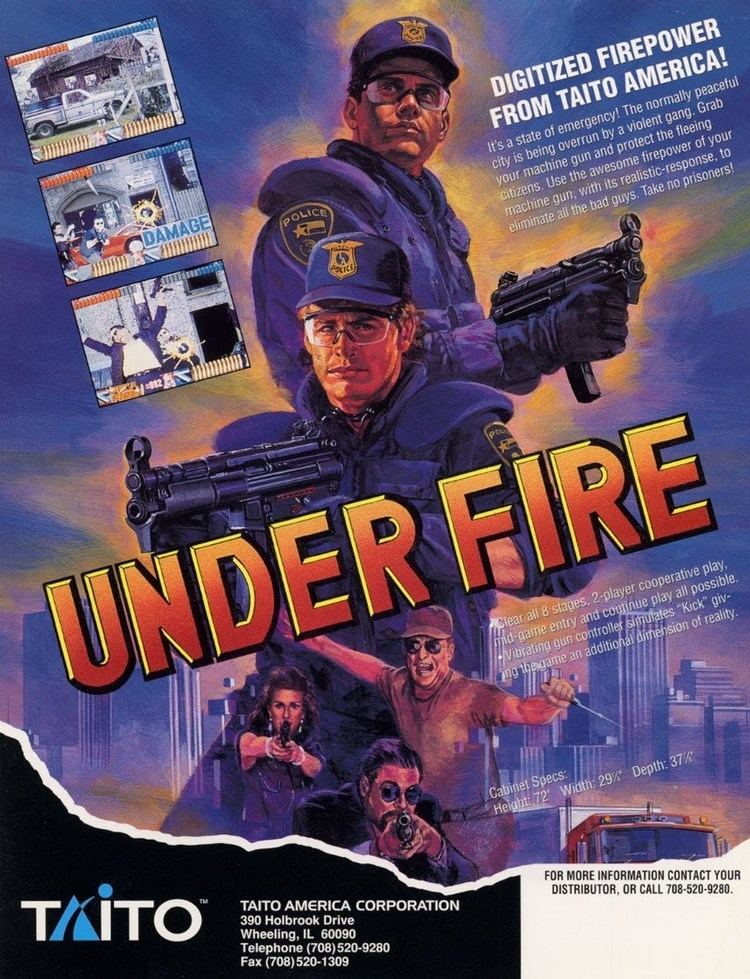Composer(s) Karu (Zuntana) Sound YM2610 | Genre(s) Shooting gallery Initial release date 1993 | |
 | ||
Mode(s) Up to two players, simultaneous CPU MC68000 @ 16MHz & MC68000 @ 12MHz Similar Operation Wolf 3, Lethal Enforcers II: Gun Fi, Lethal Enforcers, Steel Gunner, Super Chase: Criminal | ||
Under Fire (アンダーファイアー Andā Faiā) is a 1993 shooter game released in video arcades by Taito Corporation. The game features graphics created using digitized photographs and two player gameplay using gun controllers, similar to Konami's Lethal Enforcers. Unlike Lethal Enforcers, the controllers are not traditional light guns but rather operate using infrared technology. They also provide force feedback when the player pulls the trigger. Like Konami's game, Under Fire is rated for mature audiences 17+ ages and older. The game was never released for home consoles.
Contents
Plot
This game takes place in a locale similar to Wheeling, Illinois (the location of Taito Corporation's North American branch). A metropolitan city is being terrorized by a gang of criminal thugs known as "Hoppers". The problem has grown so bad that not even the regular city police can stop them. Upon seeing this, the mayor calls in a special police unit armed with sub-machine guns (presumably the H&K MP5) who are dedicated to stop the crime wave at all costs and give the city back to the law-abiding citizens. They are the only ones that can save the city from the Hoppers' criminal vicegrip on the city.
Gameplay
This game is an arcade lightgun rail shooter that up to two players can play simultaneously. Players have individual life bars, and are armed with sub-machine guns. The players have to shoot the "Hoppers" down, without shooting innocent victims and fellow policemen. Players take damage if enemies shoot the player or hit them with a projectile (such as a bomb, rocket or a molotov cocktail). If players shoot an innocent victim or policeman, they will also receive damage. Sometimes enemies try to shoot an innocent victim, so the player would have to shoot the enemy that is trying to risk the innocent victim's life; doing so will increase the player's life by one point.
There are six stages in the game, with two "bonus" or "accident" stages depending on the player's accuracy. If the player has a satisfactory accuracy rating, the "accident scene" is played in which players battle a rush of criminals while trying to avoid shooting the civilians. If a player didn't shoot well enough in the stage, a "Practice Round" is played instead in which the players shoot pictures of criminals while not shooting the pictures of civilians. Players can also shoot items to get power-ups:
Reloading is done by shooting off screen. The end of each stage contains a boss fight, and all of the bosses have life meters as well. The game also features voice samples. Enemies usually taunt the player by saying: "Go to Hell!" (only in the Japanese version), "I'll kill you!", "What do you think of that?!" and "Yah!!". Innocent victims appear and shout: "Help!", "Don't shoot!" and "Help me!", while policemen say: "Freeze!" or "Hands Up!".
Reception
Under Fire was well received, but due to its use of infrared technology, it did not obtain as much popularity as Lethal Enforcers since the required infrared sensors made the game expensive to purchase. It was only available as a dedicated machine and by that time a kit existed that allowed operators to inexpensively convert existing machines to Lethal Enforcers.
